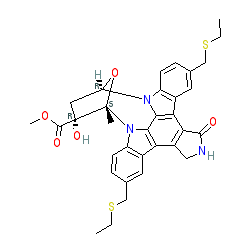GtoPdb is requesting financial support from commercial users. Please see our sustainability page for more information.
|
Synonyms: CEP 1347 | CEP1347 | KT-7515 | KT7515 [5]
Compound class:
Synthetic organic
Comment: CEP-1347 is a semi-synthetic analogue of the natural alkaloid K-252a [5]. CEP-1347 was originally identified as a pan-mixed lineage kinase (MLK) family inhibitor [8]. In this setting it inhibits downstream c-jun N-terminal kinase (JNK) activation and has neuroprotective activity [1-2,7].
Ligand Activity Visualisation ChartsThese are box plot that provide a unique visualisation, summarising all the activity data for a ligand taken from ChEMBL and GtoPdb across multiple targets and species. Click on a plot to see the median, interquartile range, low and high data points. A value of zero indicates that no data are available. A separate chart is created for each target, and where possible the algorithm tries to merge ChEMBL and GtoPdb targets by matching them on name and UniProt accession, for each available species. However, please note that inconsistency in naming of targets may lead to data for the same target being reported across multiple charts. ✖ |
|
|||||||||||||||||||||||||||||||||||
| No information available. |
Summary of Clinical Use  |
| CEP-1347 was evaluated for Parkinson's disease in humans but failed to demonstrate clinical benefit [6] (see Phase 2/3 clinical study NCT00040404). |
Mechanism Of Action and Pharmacodynamic Effects  |
| CEP-1347 blocks the activation of -Jun n-terminal kinases (JNKs) by inhibiting upstream mixed lineage kinases (MLKs) [5]. Inhibition of the JNK pathway is proposed to provide neuroprotective effects which may delay the progression of motor dysfunction in neurodegenerative conditions such as Parkinson's disease [4,8]. |
| Clinical Trials | |||||
| Clinical Trial ID | Title | Type | Source | Comment | References |
| NCT00040404 | Safety and Efficacy Study of CEP-1347 in the Treatment of Parkinson's Disease | Phase 2/Phase 3 Interventional | Teva Pharmaceutical Industries | ||







